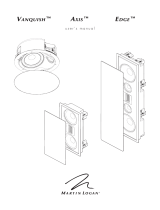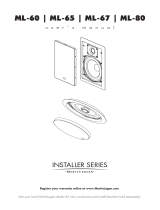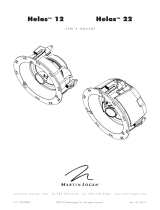
®
In-Wall Backbox Install Manual

2
WARNING!
• Refer servicing to a qualified technician.
• To prevent fire or shock hazard, do not
expose this module to moisture.
• Turn the amplifier off should any abnormal
conditions occur.
• Do not drive speaker beyond its rated power.
Content Check List.........................3
Connection ..............................4
Protect Your Investment .....................4
Break-In ................................4
Speaker Placement ........................4
Achieving Superior Imaging . . . . . . . . . . . . . . . . . . . .4
Balancing Hard vs. Soft Surfaces Improves
High- and Mid-Frequency Performance ............4
Painting the Speaker Grille ..................5
Pre-Installation Checklist....................6
Part Identification .........................7
Installation ..........................8 - 22
Attaching Bottom Bracket......................8
Back Box Preparation.........................9
Back Box Installation ........................10
Connect Speaker Wire.......................11
Positioning the Install Board ...................12
Securing the Install Board.....................13
Adjusting the Install Board ....................14
Attach Sheet Rock Clips ......................15
Hang the Sheet Rock ........................16
Mating Sheet Rock to the Install Board ...........17
Break Off Sheet Rock Clip Fingers ..............18
Sheet Rock Finishing Preparation ...............19
Sheet Rock Finishing Part 1....................20
Sheet Rock Finishing Part 2....................21
Painting Tips ..............................22
Dimensional Drawing .....................23
Per the European Union WEEE (Waste Electrical and
Electronic Equipment) directive effective August 13,
2005, we would like to notify you that this product
may contain regulated materials which upon disposal,
according to the WEEE directive, requires special reuse
and recycling processing. For this reason, Martin Logan
has arranged with our distributors in European Union
member nations to collect and recycle this product at
no cost to you.
To find your local distributor, please contact the dealer
from whom you purchased this product, email
[email protected] or visit the distributor locator at
www.martinlogan.com.
Please note, only this product itself falls under the
WEEE directive. When disposing of the packaging and
other related shipping materials, we encourage you to
recycle these items through the usual channels.
The lightning bolt flash with arrowhead symbol
within an equilateral triangle is intended to
alert the user to the presence of uninsulated
“dangerous voltage” within the product’s
enclosure that may be of sufficient magnitude to
constitute a risk of electric shock.
The exclamation point within an equilateral
triangle is intended to alert the user to the
presence of important operating and maintenance
(servicing) instructions in the literature
accompanying the appliance.
The fire within an equilateral triangle is intended
to alert the user to the potential of creating a fire
hazard if they do not follow the instructions.
The dollar sign within an equilateral triangle is
intended to alert the user that they run the risk
of causing damage that could be potentially
expensive to repair if they don’t follow the
instructions.

3
Content Check List
The Statement 40XW In-Wall Kit ships in 2 boxes and includes the following items. Should you require assistance,
please call our service department at (785) 749-0133.
Box 1: “Backbox Installation Pack”
In Wall Back Box •2x Mounting Brackets •1x Bracket Spacer •10x Wood Screws (Packaged with Mounting Brackets)
Box 2: “Install Board Hardware Kit”
Install Board •Hardware Pack (12x Wood Screws •14x Sheet Rock Clips •14x Sheet Rock Screws)
Box 1
Box 2

4
These speakers are designed with easy-to-use push-style
binding posts that accept bare wire (fig. 1).
Assign the same color to the (+) and (–) terminals on both the
speaker and the amplifier. Make sure that all connections are
tight.
For convenience during the installation process, Statement
40XW has binding posts on both the top and bottom of the
enclosure. CONNECT TO ONLY 1 SET OF BINDING POSTS.
ConneCtion
• Use an amp that approximately matches the speaker’s
specified power handling.
• To avoid damage, turn down the volume of the
speaker is distorting, sounds harsh, or the bass begins
to break up.
• Tone controls and equalizers may increase the
likelihood of distortion, especially at high volumes. Use
these setting sparingly.
When you first begin to play your speakers, they may sound
a bit bass shy, due to the high quality, long-life components
used in the drivers. Allow approximately 72 hours of break-in at
90 dB (moderate listening levels) before any critical listening.
Break-in
ProteCt Your investment
Achieving Superior Imaging
For best performance and imaging, place the speakers
equidistant to the primary listening position. It is
recommended that the primary listening position be 1x -2x
the distance between the speakers for optimal imaging. For
example, if your speakers are 10 feet apart, then the optimal
listening distance is between 10 and 20 feet away. Guidance
for speaker height can be found on page 6 in the “Pre-
Installation Checklist” section.
Balancing Hard vs. Soft Surfaces Improves High- and
Mid-Frequency Performance
Rooms that are “overdamped” with carpeting, drapes, and
other sound absorbers can cause your system to be dull
and lifeless. On the other hand, rooms can have so many
hard surfaces that the system sounds like a gymnasium.
Experiment by adding or removing soft surfaces until you find
a mix that is right for you.
sPeaker PlaCement
Fig. 1
WARNING! Turn your amplifier off before
making or breaking any signal connections!

5
Painting the sPeaker grille
IMPORTANT!
The Statement 40XW grille is packaged with the
driver assembly (STATE40XW) and not in the same packaging
as the install kit. The speaker includes an extra scrim.
1. Remove the grille from the speaker. A protective cloth
scrim is attached to the back of the grille with a low-tack
adhesive. Remove this scrim by gently pulling it away
from the grille and discard it.
2. Paint the grille, being careful not to plug the holes.
Allow the paint to dry completely before proceeding.
IMPORTANT! For best results use a spray rather than a
brush or roller.
3. Gently press the new scrim into place before reinstalling
the speaker grille.

6
Pre-installation CheCklist
NOTE: These instructions assume the mounting surface is of
standard wood frame and conventional sheetrock construc-
tion. If you wish to mount the speakers to another type of
material, you should contact a bonded contractor.
NOTE:
See your local dealer for new construction pre-
install brackets (sold separately).
WARNING! Before installing check local
building codes to verify compliance with local
regulations. WARNING!
Before installing
check for obstructions behind drywall. To do
this make a small cut-out, cutting at a 45°
angle (this makes the hole easier to patch if
you find obstacles. Only cut out the mounting
hole after you have verified there are no
obstructions behind the drywall. WARNING!
Use speaker cable rated for in-wall use.
The UL standard is CL2, CL3, and CM. The
CSA standard is FT4. WARNING! Turn your
amplifier off before making or breaking any
signal connections.
1. Be sure the wall framing is plumb and the stud spacing
is correct. (16” Minimum - 18” Maximum on center
stud spacing)
2. Speaker wire should be ran to each of the designated
stud bays before beginning the install. The in wall
back box has binding posts on the top and bot-
tom for ease of connection only. Statement
40XW requires that only 1 connection be made.
3. Please ensure the chosen stud bays are clear of all
obstructions. If plumbing, electrical, or another obstruc-
tion is present that cannot be safely relocated, please
consult the back box dimensional drawing to verify
potential fitment interference
A simple and effective way to test for potential fitment
issues is to use one of the included back box mounting
brackets as a check gauge- placing it in the stud bay and
moving it over possible interferences. If anything makes
contact with the bracket, it will interfere with the back box
and must be relocated in order to use that stud bay.
4. The overall height of the Statement 40XW drivers is
around 53” tall. We recommend that the seated ear
level at the primary listening position(s) fall within the
middle 40” of the driver assembly. Essentially making
sure that ear level is around 6.5” or more above the
bottom of the lowest speaker driver. Please note, that
the height of the in-wall enclosure will be the ultimate
limiting factor on how high the speaker can be mounted
within the stud bay. The large height of the driver
assembly means that most typical seating heights will be
well within the “sweet spot” of the speaker.
Tools you’ll need before sheet rock work:
-Tape Measure
-Laser Level (recommended)
-Ladder
-Power drill/driver
-#2 Phillips driver bit
-#2 Phillips Hand Screwdriver
-Wire Strippers
Sheet rock installation/finishing:
-Mesh sheetrock tape
-45 minute sheetrock joint compound
-Lightweight sheetrock mud
-Medium Grit Sanding Sponge
-½” or 5/8” sheet rock (depends on installation
requirements)
-General sheetrock finishing equipment
PLEASE NOTE: INSTALLATION IS A 2 PERSON JOB.

7
Part identifiCation
1
2
2
3
7
8
3
66
5
4
1 Install Board
2 Positioning Brackets
3 Mounting Brackets
4 Alignment Pins
5 Back Box
6 Positioning Bracket Pockets
7 Positioning Board
8 Bracket Spacer

8
installation
STEP 1: CRUCIAL STEP! ATTACHING THE BOTTOM
BRACKET
1a Mark the desired bracket height from the floor on
the studs.
1b Ensure the bracket is level using the attached bubble
level. Once level, attach the bracket to the studs with
(4) included wood screws. Metal studs will require
different screws that are not included.
1c Apply (1) spacer to the top of the bracket as shown, by
peeling the backer off of the attached adhesive tape.
A simple and effective way to test for potential fitment
issues is to use one of the included back box mounting
brackets as a check gauge- placing it in the stud bay
and moving it over possible interferences. If anything
makes contact with the bracket, it will interfere with the
back box and must be relocated in order to use that
stud bay.
1d Repeat the steps above for any additional 40XW bottom
brackets, if installing multiples. Use a laser level to
ensure the speakers will be on the same plane once
installation is complete.

9
STEP 2: BACK BOX PREPARATION
2a Carefully remove the back box from its packaging.
Confirm the proper orientation of the back box using the
diagram on the positioning board:
LC UP = LEFT CHANNEL UP
RC UP = RIGHT CHANNEL UP
2b With the correct orientation pointing upwards, seat the
remaining bracket on the top of the back box by guid-
ing the locating pins on the back box into the holes in
the top bracket. Top bracket should be oriented as
depicted in the figure

10
STEP 3: BACK BOX INSTALLATION
3a With the correct orientation pointing upwards, lift the
back box and seat it into the holes in the bottom bracket
spacer using the locating pins for alignment.
3b Carefully push the back box into the stud bay. Please
ensure the top bracket can sit flush against the studs just
like the bottom bracket. A helper should now hold the
back box in place to complete the next step.
3c While the back box is being held in place, ensure the top
bracket is seated down firmly on the top of the back box.
Then secure the bracket to the studs with (4) supplied
wood screws. Metal studs will require different
screws that are not included.

11
STEP 4: CONNECT SPEAKER WIRE TO TOP OR BOT-
TOM BINDING POSTS
4a Connect the speaker wire to either the top binding
posts OR bottom binding posts. The in wall back box
has binding posts on the top and bottom for ease of
connection only. Statement 40XW requires that only
1 connection be made. DO NOT CONNECT AN
AMPLIFIER CHANNEL TO BOTH THE TOP AND
BOTTOM, USE ONLY 1.

12
STEP 5: POSITIONING THE INSTALL BOARD
5a Carefully remove the install board from its packaging.
Ensure the install board thickness matches that of the
intended wall surface. Both 1/2” and 5/8” kits are
available.
5b Position the install board on the back box by seating the
positioning brackets into the pockets on the positioning
board. Ensure all brackets are fully seated and touching
the bottom of their respective pockets.

13
STEP 6: SECURING THE INSTALL BOARD
6a Secure the install board to the studs through the 12
slots indicated above using the (12) included wood
screws. Metal studs will require different screws
that are not included.
x 12

14
STEP 7: CRUCIAL STEP! ADJUSTING THE
INSTALL BOARD
7a The adjustment blocks on the install board allow for
fine tuning of the speaker opening, ensuring perfect
alignment of the finished installation. To lock in the
desired install board adjustments, tighten the 12
adjustment blocks hand-tight with a Phillips screw driver.
7b You may need to push in and hold down an adjustment
bracket so it sits flush in it’s pocket while tightening the
adjustment blocks. The goal is to make sure the install
board sits as tight as possible to the positioning board
first- and then locking in that position by tightening the
adjustment block. Repeat for each of the 12 adjustment
blocks as necessary.
7c After tightening all the adjustment blocks, push on the
install board. If it can flex in any area, tighten the nearest
adjustment block further.

15
STEP 8: ATTACH SHEET ROCK CLIPS
8a Attach the included sheetrock clips to the install board in
the 14 recessed locations around the perimeter. Ensure
the “fingers” are facing forward.
8b Drive (1) included sheet rock screw through the face of
the install board and into the sheet rock clip for each
location as shown.

16
STEP 9: HANG THE SHEET ROCK
9a Hang the sheet rock on the stud wall. The opening
around the Fiberock® install board can be measured
and cut before application. Alternatively, sheet rock
can be loosely hung over the install board and then an
opening cut with a drywall saw using the perimeter of
the install board as a guide. If using this method, avoid
cutting into the sheet rock clips.
NOTE:The surfaces of the sheet rock and install
board will not be on the same plane. The clips
force the sheet rock to be proud of the install board
surface. This is done intentionally.

17
STEP 10: MATING SHEET ROCK TO THE
INSTALL BOARD
10a After securing the sheet rock to the studs as per normal
construction, mate the install board to the surrounding
sheet rock by driving a screw through the sheet rock
into the other end of the sheet rock clip behind it. For
easy reference, the clips will be directly across from the
locations used in step 8.
10b When bridging the joint in two pieces of sheet rock, be
sure to secure both to the clip. Example shown in the
magnified insert above.

18
STEP 11: BREAK OFF DRYWALL CLIP FINGERS
11a Snap off the drywall clip fingers using a back and forth
motion as shown in the figure below.

19
STEP 12: SHEET ROCK FINISHING PREPARATION
12a Apply mesh sheet rock tape to joints and slots as indi-
cated in the diagram.
WARNING: Mesh sheet rock tape
is required. Do not use traditional
paper sheetrock tape.

20
STEP 13: SHEET ROCK FINISHING PART 1 - JOINT
COMPOUND APPLICATION
13a Apply quick 45 minute joint compound to the install
board. As noted in Step 9, the sheet rock will be
sitting proud of the install board surface. Apply joint
compound to the face of the install board, bringing
it up level with the sheet rock. Be sure to fill in the
connecting sheet rock sheet joints
13b After the compound has cured, sand in preparation for
the lightweight coat.
NOTE: The sheet metal face of the install board must
be exposed. Sand the area free of sheet rock mud
buildup before proceeding to the next step.
La page charge ...
La page charge ...
La page charge ...
La page charge ...
La page charge ...
La page charge ...
La page charge ...
La page charge ...
La page charge ...
La page charge ...
La page charge ...
La page charge ...
La page charge ...
La page charge ...
La page charge ...
La page charge ...
La page charge ...
La page charge ...
La page charge ...
La page charge ...
La page charge ...
La page charge ...
La page charge ...
La page charge ...
La page charge ...
La page charge ...
La page charge ...
La page charge ...
La page charge ...
La page charge ...
-
 1
1
-
 2
2
-
 3
3
-
 4
4
-
 5
5
-
 6
6
-
 7
7
-
 8
8
-
 9
9
-
 10
10
-
 11
11
-
 12
12
-
 13
13
-
 14
14
-
 15
15
-
 16
16
-
 17
17
-
 18
18
-
 19
19
-
 20
20
-
 21
21
-
 22
22
-
 23
23
-
 24
24
-
 25
25
-
 26
26
-
 27
27
-
 28
28
-
 29
29
-
 30
30
-
 31
31
-
 32
32
-
 33
33
-
 34
34
-
 35
35
-
 36
36
-
 37
37
-
 38
38
-
 39
39
-
 40
40
-
 41
41
-
 42
42
-
 43
43
-
 44
44
-
 45
45
-
 46
46
-
 47
47
-
 48
48
-
 49
49
-
 50
50
























































